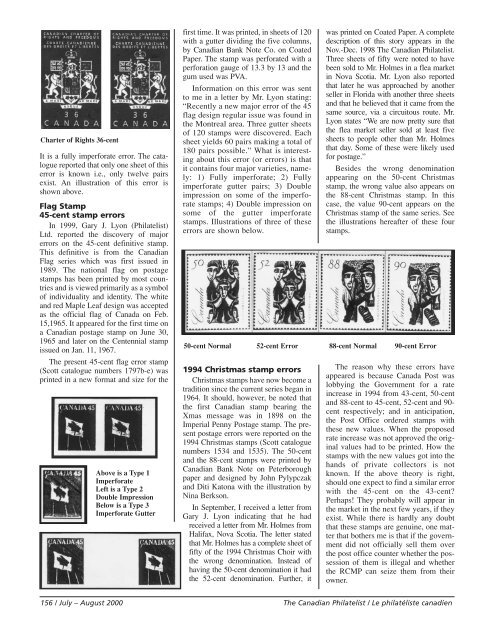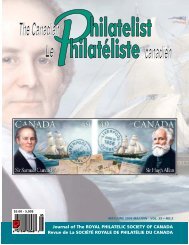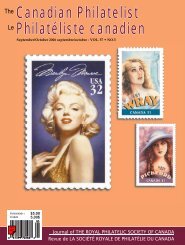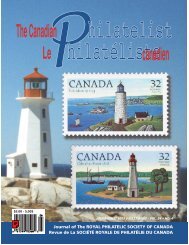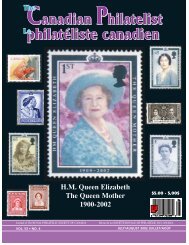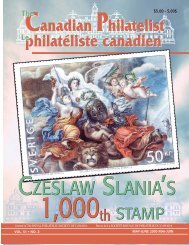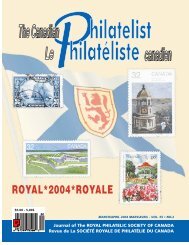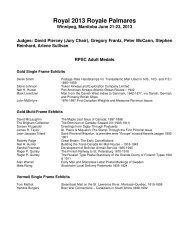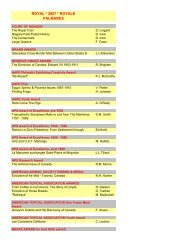Phil pages July-Aug-Final - The Royal Philatelic Society of Canada
Phil pages July-Aug-Final - The Royal Philatelic Society of Canada
Phil pages July-Aug-Final - The Royal Philatelic Society of Canada
Create successful ePaper yourself
Turn your PDF publications into a flip-book with our unique Google optimized e-Paper software.
Charter <strong>of</strong> Rights 36-cent<br />
It is a fully imperforate error. <strong>The</strong> catalogue<br />
reported that only one sheet <strong>of</strong> this<br />
error is known i.e., only twelve pairs<br />
exist. An illustration <strong>of</strong> this error is<br />
shown above.<br />
Flag Stamp<br />
45-cent stamp errors<br />
In 1999, Gary J. Lyon (<strong>Phil</strong>atelist)<br />
Ltd. reported the discovery <strong>of</strong> major<br />
errors on the 45-cent definitive stamp.<br />
This definitive is from the Canadian<br />
Flag series which was first issued in<br />
1989. <strong>The</strong> national flag on postage<br />
stamps has been printed by most countries<br />
and is viewed primarily as a symbol<br />
<strong>of</strong> individuality and identity. <strong>The</strong> white<br />
and red Maple Leaf design was accepted<br />
as the <strong>of</strong>ficial flag <strong>of</strong> <strong>Canada</strong> on Feb.<br />
15,1965. It appeared for the first time on<br />
a Canadian postage stamp on June 30,<br />
1965 and later on the Centennial stamp<br />
issued on Jan. 11, 1967.<br />
<strong>The</strong> present 45-cent flag error stamp<br />
(Scott catalogue numbers 1797b-e) was<br />
printed in a new format and size for the<br />
Above is a Type 1<br />
Imperforate<br />
Left is a Type 2<br />
Double Impression<br />
Below is a Type 3<br />
Imperforate Gutter<br />
first time. It was printed, in sheets <strong>of</strong> 120<br />
with a gutter dividing the five columns,<br />
by Canadian Bank Note Co. on Coated<br />
Paper. <strong>The</strong> stamp was perforated with a<br />
perforation gauge <strong>of</strong> 13.3 by 13 and the<br />
gum used was PVA.<br />
Information on this error was sent<br />
to me in a letter by Mr. Lyon stating:<br />
“Recently a new major error <strong>of</strong> the 45<br />
flag design regular issue was found in<br />
the Montreal area. Three gutter sheets<br />
<strong>of</strong> 120 stamps were discovered. Each<br />
sheet yields 60 pairs making a total <strong>of</strong><br />
180 pairs possible.” What is interesting<br />
about this error (or errors) is that<br />
it contains four major varieties, namely:<br />
1) Fully imperforate; 2) Fully<br />
imperforate gutter pairs; 3) Double<br />
impression on some <strong>of</strong> the imperforate<br />
stamps; 4) Double impression on<br />
some <strong>of</strong> the gutter imperforate<br />
stamps. Illustrations <strong>of</strong> three <strong>of</strong> these<br />
errors are shown below.<br />
1994 Christmas stamp errors<br />
Christmas stamps have now become a<br />
tradition since the current series began in<br />
1964. It should, however, be noted that<br />
the first Canadian stamp bearing the<br />
Xmas message was in 1898 on the<br />
Imperial Penny Postage stamp. <strong>The</strong> present<br />
postage errors were reported on the<br />
1994 Christmas stamps (Scott catalogue<br />
numbers 1534 and 1535). <strong>The</strong> 50-cent<br />
and the 88-cent stamps were printed by<br />
Canadian Bank Note on Peterborough<br />
paper and designed by John Pylypczak<br />
and Diti Katona with the illustration by<br />
Nina Berkson.<br />
In September, I received a letter from<br />
Gary J. Lyon indicating that he had<br />
received a letter from Mr. Holmes from<br />
Halifax, Nova Scotia. <strong>The</strong> letter stated<br />
that Mr. Holmes has a complete sheet <strong>of</strong><br />
fifty <strong>of</strong> the 1994 Christmas Choir with<br />
the wrong denomination. Instead <strong>of</strong><br />
having the 50-cent denomination it had<br />
the 52-cent denomination. Further, it<br />
was printed on Coated Paper. A complete<br />
description <strong>of</strong> this story appears in the<br />
Nov.-Dec. 1998 <strong>The</strong> Canadian <strong>Phil</strong>atelist.<br />
Three sheets <strong>of</strong> fifty were noted to have<br />
been sold to Mr. Holmes in a flea market<br />
in Nova Scotia. Mr. Lyon also reported<br />
that later he was approached by another<br />
seller in Florida with another three sheets<br />
and that he believed that it came from the<br />
same source, via a circuitous route. Mr.<br />
Lyon states “We are now pretty sure that<br />
the flea market seller sold at least five<br />
sheets to people other than Mr. Holmes<br />
that day. Some <strong>of</strong> these were likely used<br />
for postage.”<br />
Besides the wrong denomination<br />
appearing on the 50-cent Christmas<br />
stamp, the wrong value also appears on<br />
the 88-cent Christmas stamp. In this<br />
case, the value 90-cent appears on the<br />
Christmas stamp <strong>of</strong> the same series. See<br />
the illustrations hereafter <strong>of</strong> these four<br />
stamps.<br />
50-cent Normal 52-cent Error 88-cent Normal 90-cent Error<br />
<strong>The</strong> reason why these errors have<br />
appeared is because <strong>Canada</strong> Post was<br />
lobbying the Government for a rate<br />
increase in 1994 from 43-cent, 50-cent<br />
and 88-cent to 45-cent, 52-cent and 90-<br />
cent respectively; and in anticipation,<br />
the Post Office ordered stamps with<br />
these new values. When the proposed<br />
rate increase was not approved the original<br />
values had to be printed. How the<br />
stamps with the new values got into the<br />
hands <strong>of</strong> private collectors is not<br />
known. If the above theory is right,<br />
should one expect to find a similar error<br />
with the 45-cent on the 43-cent?<br />
Perhaps! <strong>The</strong>y probably will appear in<br />
the market in the next few years, if they<br />
exist. While there is hardly any doubt<br />
that these stamps are genuine, one matter<br />
that bothers me is that if the government<br />
did not <strong>of</strong>ficially sell them over<br />
the post <strong>of</strong>fice counter whether the possession<br />
<strong>of</strong> them is illegal and whether<br />
the RCMP can seize them from their<br />
owner.<br />
156 / <strong>July</strong> – <strong>Aug</strong>ust 2000 <strong>The</strong> Canadian <strong>Phil</strong>atelist / Le philatéliste canadien


